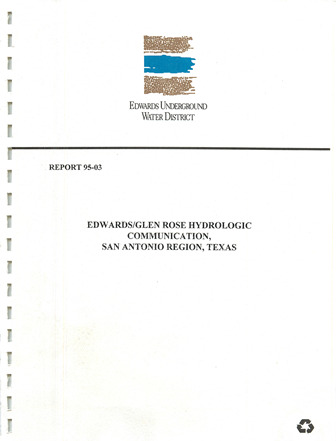Edwards/Glen Rose Hydrologic Communication, San Antonio Region, Texas

| Author | LBG-Guyton Associates |
| Year | 1995 |
| Description | Hydrogeological and modeling study of transmissivity between the Glen Rose and Edwards aquifers in the Cibolo Creek Basin and Guadalupe River |
| Report Number | 95-03 |
| Publisher | Edwards Underground Water District |
| Location | Edwards Aquifer Balcones Fault Zone San Antonio Segment, Glen Rose Aquifer, Cibolo Creek Basin, TX |
| Cover | View Download |
| File | View Download |
| Summary |
|
This report presents the results from a study conducted to evaluate and estimate the amount of water that might move directly from the Glen Rose aquifer into the Edwards aquifer in the San Antonio region. Three main approaches were used for identifying hydrologic communication and the potential amount of flow between the Glen Rose and the Edwards aquifers: (1) geologic evidence, (2) hydrologic evidence and (3) hydrochemical evidence. The geologic and hydrologic evidence was used both on a site-specific area (Haby Crossing fault area) and regionally to determine quantities of inflow from the Glen Rose. Hydrologic communication between the Glen Rose and Edwards aquifers in the Cibolo Creek basin has previously been considered different from water transfers between the two aquifers elsewhere. Historically, recharge to the Edwards aquifer in Cibolo Creek basin has been calculated using stream losses from Boerne to Bracken, even though lower Glen Rose is exposed in the creek between Boerne and Bulverde. Based principally on stream-loss records, available water-level records and the absence of a previously known discharge area, recharge has been assumed to enter the Edwards aquifer as underflow from the Glen Rose Formation in the subsurface through a shallow karst system under Cibolo Creek. However, mapping of the extent of Honey Creek Cave, northeast of Cibolo Creek in this area, and hydrogeologic observations indicate that some water is diverted through cave conduits to the Guadalupe River. As a result, the large stream losses in Cibolo Creek over the lower Glen Rose member previously used to calculate Edwards aquifer recharge may not find its way to the Edwards aquifer unless the water is recharged in the Guadalupe River basin. The Haby Crossing fault area, because of the relatively large fault displacement, is one of the best locations for the Edwards and Glen Rose Limestones to be juxtaposed to one another, which gives the best potential for hydrologic communication between the two aquifers. Based on calculations from water-level and pumping-test data, it is estimated that about 360 acre-feet per year (ac-ft/yr) of inflow could be transmitted to the Edwards aquifer along a 14-mile length of the Haby Crossing fault under 1994 water-level conditions. This amount is relatively small compared to the average calculated direct recharge in the Medina River basin (about 61,000 ac-ft/yr, as calculated by the U. S. Geological Survey) and the average total aquifer recharge (about 682,800 ac-ft/yr) for the Edwards aquifer in the San Antonio region. Geochemical modeling confirms that only small amounts of Glen Rose water are entering the Edwards aquifer as compared to other recharge sources, possibly on the order of 5 percent of the total water immediately downgradient of the Haby Crossing fault. This initial mix of Edwards and Glen Rose water continues to be diluted as the water travels downgradient toward the main artesian part of the Edwards aquifer near San Antonio. Based on geochemical models using NETPATH and median chemical values, the chemical content of water representative of the Edwards aquifer in the San Antonio region is diluted to less than 1 percent Glen Rose water as compared to the total water content. Regionally, underflow from the Glen Rose Formation to the Edwards aquifer along the Balcones fault zone can occur by ground water moving laterally in a downgradient direction within the Glen Rose and entering the Edwards aquifer through fault planes. The amount of ground water in transit is dependent on the length of the line of entry (fault plane) through which water enters the Edwards aquifer, the water level gradient across the fault plane from the Glen Rose to the Edwards aquifer, and the effective transmissivity for the Glen Rose aquifer upgradient and along this line. Using this method, which excludes recharge in Cibolo Creek through the lower Glen Rose to the Edwards and contributions from the Edwards-Trinity Plateau aquifer at the western end of the aquifer, an approximate range of total Glen Rose underflow to the Edwards aquifer would be about 2, 700 to about 11,400 ac-ft/yr in the San Antonio region. These estimates are based on high and low median transmissivities and a positive water-level gradient from the Glen Rose to the Edwards aquifer. As compared to the total Edwards aquifer water budget, these estimates indicate that the Glen Rose contribution is probably less than 2 percent of the total water budget during average recharge conditions. |
Search for Documents
Advance Search
Explore EAA's Scientific Reports
- All Reports
- Water Quality
- Climatology
- Surface Water / Groundwater Relationship
- Biology
- Springs, Groundwater Discharge
- Archaeology
- RZ Protection
- Aquifer Levels
- Remote Sensing
- Precipitation
- Overview Studies
- Modeling
- Hydrology and Hydrogeology
- History
- Groundwater Recharge, Recharge Zone
- Groundwater Movement
- Geomorphology and Caves
- Weather Modification
- Geology
- Water Use and Conservation
- Geochemistry
- Water Resources Planning and Management
- Floods and Drought
